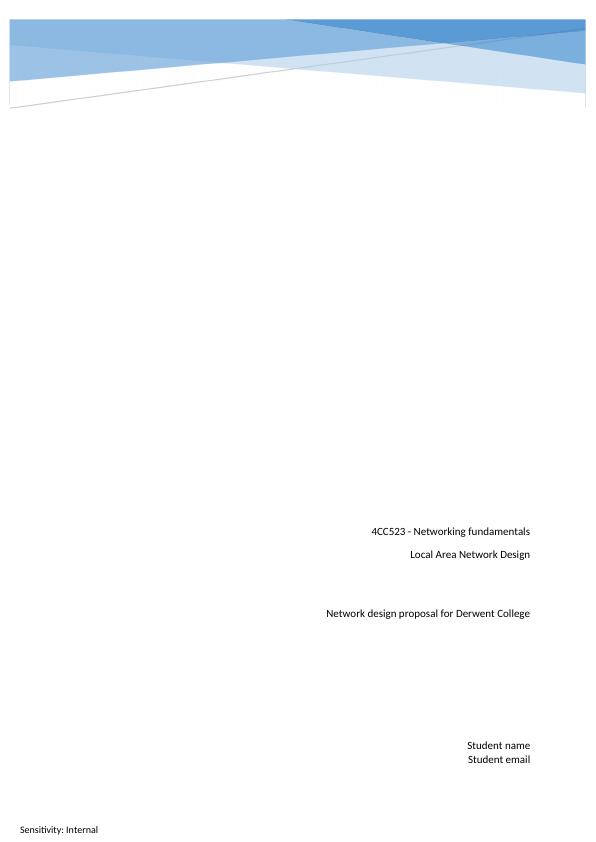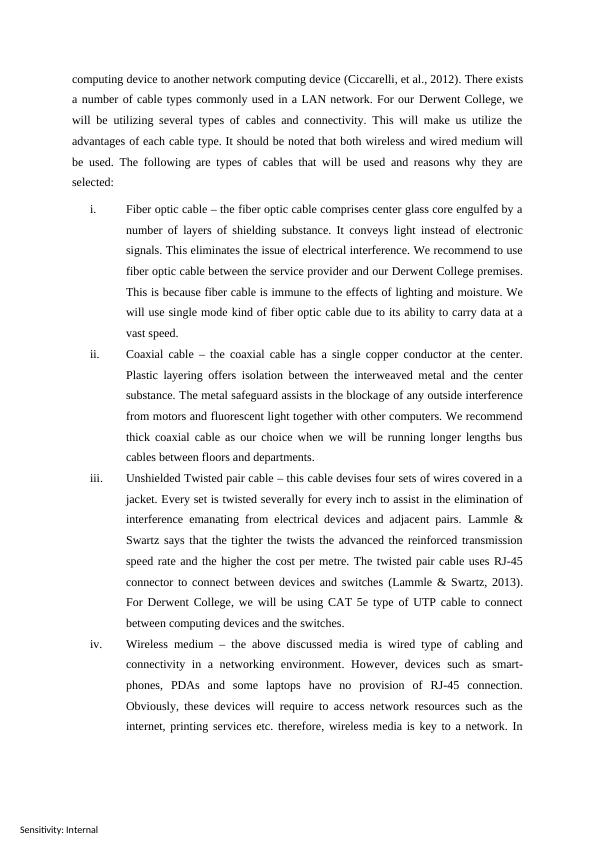Network Design Proposal for Derwent College
Added on 2023-04-19
13 Pages2554 Words362 Views
Sensitivity: Internal
4CC523 - Networking fundamentals
Local Area Network Design
Student name
Student email
Network design proposal for Derwent College
4CC523 - Networking fundamentals
Local Area Network Design
Student name
Student email
Network design proposal for Derwent College

Sensitivity: Internal
1. Introduction and Requirements of the Report
At the centre of every educational area is the network. An educational centre cannot function
properly without network infrastructure. Derwent College is not an exception. It should be
noted that most of the mission-critical items required for operational and organizational
structures are embedded in a network. It is therefore a necessity for our case study college to
have a network structure laid during its inception.
Derwent College has an approximate population of 1050 users. You can imagine if every user
was to be allocated his/her own printer, file storage, mail and messaging server, DHCP server
and DNS server. This is not cost effective. The following are the reasons why Derwent
College will require a network infrastructure:
i. Network is required to allow sharing of resources (software and hardware) within
the campus. The cost of computer has come down, however, the cost of bulk
storage, laser printer and large enterprise software has remained high. Once
Derwent College is interconnected, the above mentioned resources will be share
among students, staff and lecturers.
ii. Information exchange and collaboration, it is not possible to work together when
nobody understands what someone does in a network. The network will allow,
workers to share view other people’s and exchange ideas in an efficient manner.
Our college will require to use instant messaging and email tools to communicate
in a fast manner and keep messages for future reference.
2. Proposed Design
Panos & Konstantinos defines network design as the planning of the implementation of a
computing network infrastructure. The exercise entails evaluation, understanding and
providing the scope of the network to be implemented (Panos & Konstantinos, 2017). The
network to be implemented as a whole is represented in logical diagram which serves as the
blue-print for the implementation. For Derwent College, network design will include the
below;
2.1 Cabling and connectivity
Network cabling and connectivity comprises of how computing components are attached to
each other for the purposes of communicating to one another. Ciccarelli, et al refers to a
network cable as medium via which information typically travels from one network
1. Introduction and Requirements of the Report
At the centre of every educational area is the network. An educational centre cannot function
properly without network infrastructure. Derwent College is not an exception. It should be
noted that most of the mission-critical items required for operational and organizational
structures are embedded in a network. It is therefore a necessity for our case study college to
have a network structure laid during its inception.
Derwent College has an approximate population of 1050 users. You can imagine if every user
was to be allocated his/her own printer, file storage, mail and messaging server, DHCP server
and DNS server. This is not cost effective. The following are the reasons why Derwent
College will require a network infrastructure:
i. Network is required to allow sharing of resources (software and hardware) within
the campus. The cost of computer has come down, however, the cost of bulk
storage, laser printer and large enterprise software has remained high. Once
Derwent College is interconnected, the above mentioned resources will be share
among students, staff and lecturers.
ii. Information exchange and collaboration, it is not possible to work together when
nobody understands what someone does in a network. The network will allow,
workers to share view other people’s and exchange ideas in an efficient manner.
Our college will require to use instant messaging and email tools to communicate
in a fast manner and keep messages for future reference.
2. Proposed Design
Panos & Konstantinos defines network design as the planning of the implementation of a
computing network infrastructure. The exercise entails evaluation, understanding and
providing the scope of the network to be implemented (Panos & Konstantinos, 2017). The
network to be implemented as a whole is represented in logical diagram which serves as the
blue-print for the implementation. For Derwent College, network design will include the
below;
2.1 Cabling and connectivity
Network cabling and connectivity comprises of how computing components are attached to
each other for the purposes of communicating to one another. Ciccarelli, et al refers to a
network cable as medium via which information typically travels from one network

Sensitivity: Internal
computing device to another network computing device (Ciccarelli, et al., 2012). There exists
a number of cable types commonly used in a LAN network. For our Derwent College, we
will be utilizing several types of cables and connectivity. This will make us utilize the
advantages of each cable type. It should be noted that both wireless and wired medium will
be used. The following are types of cables that will be used and reasons why they are
selected:
i. Fiber optic cable – the fiber optic cable comprises center glass core engulfed by a
number of layers of shielding substance. It conveys light instead of electronic
signals. This eliminates the issue of electrical interference. We recommend to use
fiber optic cable between the service provider and our Derwent College premises.
This is because fiber cable is immune to the effects of lighting and moisture. We
will use single mode kind of fiber optic cable due to its ability to carry data at a
vast speed.
ii. Coaxial cable – the coaxial cable has a single copper conductor at the center.
Plastic layering offers isolation between the interweaved metal and the center
substance. The metal safeguard assists in the blockage of any outside interference
from motors and fluorescent light together with other computers. We recommend
thick coaxial cable as our choice when we will be running longer lengths bus
cables between floors and departments.
iii. Unshielded Twisted pair cable – this cable devises four sets of wires covered in a
jacket. Every set is twisted severally for every inch to assist in the elimination of
interference emanating from electrical devices and adjacent pairs. Lammle &
Swartz says that the tighter the twists the advanced the reinforced transmission
speed rate and the higher the cost per metre. The twisted pair cable uses RJ-45
connector to connect between devices and switches (Lammle & Swartz, 2013).
For Derwent College, we will be using CAT 5e type of UTP cable to connect
between computing devices and the switches.
iv. Wireless medium – the above discussed media is wired type of cabling and
connectivity in a networking environment. However, devices such as smart-
phones, PDAs and some laptops have no provision of RJ-45 connection.
Obviously, these devices will require to access network resources such as the
internet, printing services etc. therefore, wireless media is key to a network. In
computing device to another network computing device (Ciccarelli, et al., 2012). There exists
a number of cable types commonly used in a LAN network. For our Derwent College, we
will be utilizing several types of cables and connectivity. This will make us utilize the
advantages of each cable type. It should be noted that both wireless and wired medium will
be used. The following are types of cables that will be used and reasons why they are
selected:
i. Fiber optic cable – the fiber optic cable comprises center glass core engulfed by a
number of layers of shielding substance. It conveys light instead of electronic
signals. This eliminates the issue of electrical interference. We recommend to use
fiber optic cable between the service provider and our Derwent College premises.
This is because fiber cable is immune to the effects of lighting and moisture. We
will use single mode kind of fiber optic cable due to its ability to carry data at a
vast speed.
ii. Coaxial cable – the coaxial cable has a single copper conductor at the center.
Plastic layering offers isolation between the interweaved metal and the center
substance. The metal safeguard assists in the blockage of any outside interference
from motors and fluorescent light together with other computers. We recommend
thick coaxial cable as our choice when we will be running longer lengths bus
cables between floors and departments.
iii. Unshielded Twisted pair cable – this cable devises four sets of wires covered in a
jacket. Every set is twisted severally for every inch to assist in the elimination of
interference emanating from electrical devices and adjacent pairs. Lammle &
Swartz says that the tighter the twists the advanced the reinforced transmission
speed rate and the higher the cost per metre. The twisted pair cable uses RJ-45
connector to connect between devices and switches (Lammle & Swartz, 2013).
For Derwent College, we will be using CAT 5e type of UTP cable to connect
between computing devices and the switches.
iv. Wireless medium – the above discussed media is wired type of cabling and
connectivity in a networking environment. However, devices such as smart-
phones, PDAs and some laptops have no provision of RJ-45 connection.
Obviously, these devices will require to access network resources such as the
internet, printing services etc. therefore, wireless media is key to a network. In

Sensitivity: Internal
fact, Lammle affirms that more networking devices operate without network
cables (Lammle, 2015). Derwnt College is not an exception.
Medium Type Advantages Disadvantages
Fiber optic • Able to carry
information at high
speed.
• Immune to adverse
environment
• Does not experience
electrical interference
• It is very expensive
Coaxial cable • Metal coating assists
blocking of outside
interference.
• It supports greater cable
lengths between
computing devices as
compared to twisted pair
cables.
• Coaxial cable is hard to
bend and this makes it
difficult to install.
UTP cable • Cost effective
• The twisting reduces
interference
• Experiences
interference.
Wireless media • Allows portable devices,
remote computers and
laptop computers to
connect to a LAN.
• Beneficial to buildings
anywhere it may
impossible or
challenging to fix cables
• Interference is a major
threat to wireless
communication since
radio signal technique of
transmission is
vulnerable to
interference.
fact, Lammle affirms that more networking devices operate without network
cables (Lammle, 2015). Derwnt College is not an exception.
Medium Type Advantages Disadvantages
Fiber optic • Able to carry
information at high
speed.
• Immune to adverse
environment
• Does not experience
electrical interference
• It is very expensive
Coaxial cable • Metal coating assists
blocking of outside
interference.
• It supports greater cable
lengths between
computing devices as
compared to twisted pair
cables.
• Coaxial cable is hard to
bend and this makes it
difficult to install.
UTP cable • Cost effective
• The twisting reduces
interference
• Experiences
interference.
Wireless media • Allows portable devices,
remote computers and
laptop computers to
connect to a LAN.
• Beneficial to buildings
anywhere it may
impossible or
challenging to fix cables
• Interference is a major
threat to wireless
communication since
radio signal technique of
transmission is
vulnerable to
interference.

End of preview
Want to access all the pages? Upload your documents or become a member.
Related Documents
What is a Computer Network?lg...
|19
|6395
|45
LAN Network Design for IT College in Melbourne Citylg...
|11
|2014
|407
E-commerce Business LAN Design and Setuplg...
|24
|3396
|467
(solved) Assignment on Networkinglg...
|27
|5649
|353
Networking in IT infrastructure Assignmentlg...
|12
|2533
|30
Network Design Proposal Assignmentlg...
|20
|4908
|79
